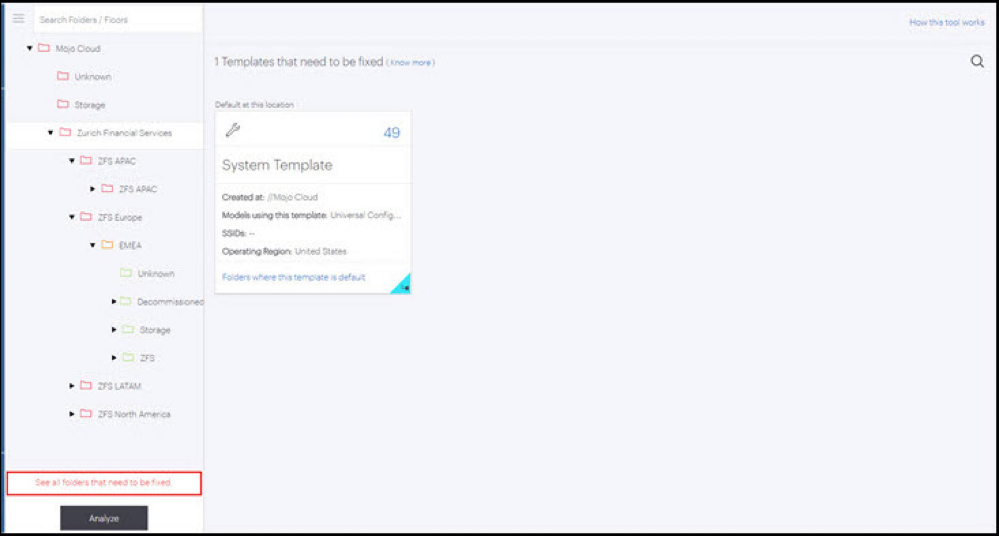Introduction to Migration Tool-2
The Migration tool phase 1 was already in use for the migration of model-specific configurations in a device template to universal configurations. Phase 1 had a few limitations. It dealt only with the migration of single, model-specific configurations in a device template to universal configurations.
With phase-2 of the Migration tool, you will be able to migrate all device templates with model-specific configurations to universal configurations. You will see a link to launch the migration tool on folders that have device templates that need migration . The migration link helps to migrate the device templates at a folder even if the default device template is migrated. On selecting a folder, you will see all the templates in that folder.
How to Launch the Migration Tool
- When you attempt to configure a folder in CV-CUE that is using an outdated
template.

- Via the tool tip of the "bird" icon for folders that have outdated templates.
Steps to use Migration Tool
Fixing a template means converting any model-specific configurations in the template to universal configurations. The main page shows templates in that folder that need fixing. The template cards also show details such as the number of devices using the template, configurations in the template, SSIDs using the template, etc.

Scenario I - A Model-Specific Configuration is Default

- Consider two types of devices:
- Type A Devices: Devices that are using this configuration because it is applied as default at their folder in the location tree.
- Type B Devices: Devices to which this template is applied directly (not via their folder).
- When you fix a template:
- You can select "Make Default" for one configuration. This makes it the
default configuration for that folder (see first card from the left in
the screenshot above, the C-60 Config). If this is a model-specific
configuration, then fixing the template converts it to a Universal
configuration with settings of the original model-specific config (C-60
in the screenshot above). For this configuration:
- Type A devices using this configuration continue to use it as the default configuration for their folder in the location tree.
- Type B devices using this configuration form a Group in CV-CUE.
- You can select "Make Default" for one configuration. This makes it the
default configuration for that folder (see first card from the left in
the screenshot above, the C-60 Config). If this is a model-specific
configuration, then fixing the template converts it to a Universal
configuration with settings of the original model-specific config (C-60
in the screenshot above). For this configuration:
- Configurations that are not being used by any devices are discarded by default. If you uncheck the Discard box, this will create an empty Group for each such configuration.
- For all other configurations in the template, devices using the configuration form Groups regardless of whether they are of Type A or Type B.
Scenario II - A Universal Configuration is Default

- Shown above is the alternative scenario - when the second card from the left (Universal Config) is chosen as "Make Default".
- This card has 1 Type A device that continues to use this configuration as default at its location.
- The 2 devices on the C-60 card now go on to form a Group.
Click "Preview" to see the effect of your choices - i.e. to see which devices form groups and which ones continue to use the configuration you have chosen as Default.Click 'Fix This Template' to confirm.
How to Analyze Location Tree
The migration of device templates can be done effectively by analyzing the entire location tree.
- Click the Auto Migrate option. The location tree will be displayed. You can see the Analyze
button at the bottom most part of the tree.

Once you click on Analyze, it starts analyzing the folders. During the analysis, you will not be able to perform any other operations on the Migration Tool.
- Once the Analysis is completed, you can see red, orange, or green folders
depending on their status.
- Red - If the folder is colored Red, it means that none of the device templates under that folder has been fixed.
- Orange - If the folder is colored orange, it means that some templates have been fixed, while others still need to be fixed.
- Green - If the location folder is colored green, it means that all the templates for that folder are fixed.
- When you click on the folder, you can see all the device templates under that folder that
need to be fixed.

- You can see the templates that need to be fixed if the color of the location folder is
either red or orange. Click on the template and fix it. If the template was
created at a parent folder, then it will throw a message asking you to
navigate to the parent folder to fix it.

